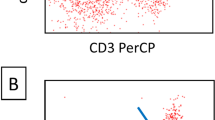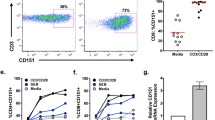Abstract
CD2 is a glycoprotein expressed on the surface of human T cells that mediates adhesion between T cells and antigen presenting cells. CD2 also functions in concert with the T cell receptor to transduce signals that lead to T cell activation. The CD8 and CD4 molecules are transmembrane glycoproteins that are expressed on mutually exclusive populations of mature T cells and bind to determinants on major histocompatibility complex class I and class II molecules respectively. Like CD2, CD4 and CD8 function to promote adhesion between T cells and antigen presenting cells and potentiate signaling via the T cell receptor. We studied a patient with idiopathic lymphopenia and disseminated infection withMycobacterium avium. The patient also suffered from recurrent deep venous thrombosis in association with anticardiolipin and anti-DNA antibodies. Peripheral blood T cells from this patient were polyclonal and expressed no detectable CD2 RNA or protein as determined by northern blotting, immunofluorescent staining with anti-CD2 antibodies, and failure to form rosettes with sheep red blood cells. In addition, the majority (85%) of this patient's T cells did not express either CD4 or CD8 but did express the α/β T cell receptor. T cells from this patient failed to respond to stimulation with alloantigen or specific antigen. In contrast, there was a normal response to stimulation with immobilized anti-CD3 antibody. The clinical and immunologic findings in this patient providein vivo evidence that the accessory molecules CD2, CD4, and CD8 play important roles in the regulation of normal human T cell activation.
Similar content being viewed by others
References
Rothbard J, Gefter M: Interactions between immunogenic peptides and MHC proteins. Annu Rev Immunol 9:527–565, 1991
Bierer B, Sleckman B, Ratnofsky S, Burakoff S: The biologic roles of CD2, CD4, and CD8 in T cell activation. Annu Rev Immunol 7:579–599, 1989
Boyum A: Separation of blood leucocytes, granulocytes and lymphocytes. Tissue Antigens 4:269–275, 1974
Geppert TD, Lipsky P: Accessory cell independent proliferation of human T4 cells stimulated by immobilized monoclonal antibodies to CD3. J Immunol 138:1660–1668, 1987
Meuer SC, Hussey RE, Fabbi M, Fox D, Acuto O, Fitzgerald KA, Hodgdon JC, Protentis JP, Schlossman SF, Reinherz EL: An alternative pathway of T-cell activation: A functional role for the 50 kd T11 sheep erythrocyte receptor protein. Cell 36:897–906, 1984
Sneller MC, Straus SE, Jaffe ES, Jaffe JS, Fleisher TA, Stetler SM, Strober W: A novel lymphoproliferative/autoimmune syndrome resembling murine lpr/gld disease. J Clin Invest 90:334–341, 1992
CDC: Guidelines for the performance of CD4 T cell determinations in persons with human Immunodeficiency virus infections. Morbid Mortal Week Rep 41:RR-8, 1992
Itoh N, Yonehara S, Ishii A, Yonehara M, Mizushima S, Sameshima M, Hase A, Seto Y, Nagata S: The polypeptide encoded by the cDNA for human cell surface antigen Fas can mediate apoptosis. Cell 66:233–243, 1991
Dorsett B, Cronin W, Chuma V, Ioachim HL: Antilymphocyte antibodies in patients with the acquired immune deficiency syndrome. Am J Med 78:621–629, 1985
Siu G, Clark SP, Yoshikai Y, Malissen M, Yanagi Y, Strauss E, Mak TW, Hood L: The human T cell antigen receptor is encoded by variable, diversity, and joining gene segments that rearrange to generate a complete V gene. Cell 37:393–403, 1984
Sewell WA, Brown MH, Dunne J, Owen MJ, Crumpton MJ: Molecular cloning of the human T-lymphocyte surface CD2 antigen. Proc Natl Acad Sci USA 83:8718–8722, 1986
Cohen PL, Eisenberg RA: Lpr and gld: single gene models of systemic autoimmunity and lymphoproliferative disease. Annu Rev Immunol 9:243–269, 1991
Watanabe-Fukunaga R, Brannan CI, Copeland NG, Jenkins NA, Nagata S: Lymphoproliferation disorder in mice explained by defects in Fas antigen that mediates apoptosis. Nature 356:314–317, 1992
Miyawaki T, Uehara T, Nibu R, Tsuji T, Yachie A, Yonehara S, Taniguchi N: Differential expression of apoptosis-related Fas antigen on lymphocyte subpopulations in human peripheral blood. J Immunol 149:3753–3758, 1992
Owen SL, Yonehara S, Crump W, Grimm EA: DNA fragmentation and cell death is selectively triggered in activated human lymphocytes by Fas antigen engagement. Cell Immunol 140:197–205, 1992
Lang G, Wotton D, Owen MJ, Sewell WA, Brown MH, Mason DY, Crumpton MJ, Kioussis D: The structure of the human CD2 gene and its expression in transgenic mice. EMBO J 7:1675–1682, 1988
Moingeon P, Chang HC, Sayre PH, Clayton LK, Alcover A, Gardner P, Reinherz EL: The structural biology of CD2. Immunol Rev 111:111–141, 1989
Shivakumar S, Tsokos G, Datta S: T cell receptor alpha/beta expressing double negative and CD4+ T helper cells in humans augment the production of pathogenic anti-DNA autoantibodies associated with lupus nephritis. J Immunol 143:103–112, 1989
de la Hera A, Toribio M, Marquez C, C M: IL-2 promotes growth and cytolytic activity in human T3+4−8-thymocytes. Proc Natl Acad Sci USA 82:6268–6271, 1985
Groh V, Fabbi M, Hochstenbach F, Maziarz R: Double negative (CD4−8-) lymphocytes bearing T cell receptor alpha and beta chains in normal human skin. Proc Natl Acad Sci USA 86:5059–5063, 1989
Wirt D, Brooks E, Vaidya S, Klimpel G, Waldman T, Goldblum R: A novel T lymphocyte population in combined immunodeficiency with features of graft-versus-host disease. N Engl J Med 321:370–374, 1989
Illum N, Ralfkiaer E, Pallesin G, Geisler C: Phenotypic and functional characterization of double-negative alpha/beta T-cell receptor positive cells from an immunodeficient patient. Scand J Immunol 34:635–645, 1991
Kabelitz D, Conradt P, Schondelmaier S, Wagner H, Haars R: A novel subset of CD2-, CD3/Tcell receptor alpha/beta+ human peripheral blood T cells. J Exp Med 170:559–569, 1989
Kabelitz D, Conradt P: Identification of CD2−/CD3+ T cells in fetal human tissue. J Exp Med 168:1941–1946, 1988
Krensky A, Robbins E, Springer T, Burakoff S: LFA1, LFA2, and LFA3 antigens are involved in CTL-target conjugation. J Immunol 132:2180–2182, 1984
Verbi W, Greaves M, Schneider C, Koubek K, Janossy G, Stein H, Kung P, Goldstein G: Monoclonal antibodies OKT11 and OKT11A have pan-T reactivity and block sheep erythrocyte receptors. J Immunol 12:81–86, 1982
Shaw S, Luce GE, Quinones R, Gress RE, Springer TA, Sanders ME: Two antigen-independent adhesion pathways used by human cytotoxic T-cell clones. Nature 323:262–264, 1986
Bierer B, Peterson A, Gorga J, Herrmann S, Burakoff S: Synergistic T cell activation via the physiological ligands for CD2 and the T cell receptor. J Exp Med 168:1145–1156, 1988
Yang SY, Chouaib S, Dupont B: A common pathway for T lymphocyte activation involving both the CD3-Ti complex and CD2 sheep erythrocyte receptor determinants. J Immunol 137:1097–1100, 1986
Krensky AM, Sanchez MF, Robbins E, Nagy JA, Springer TA, Burakoff SJ: The functional significance, distribution, and structure of LFA-1, LFA-2, and LFA-3: Cell surface antigens associated with CTL-target interactions. J Immunol 131:611–616, 1983
Sanders M, Makgoba M, Sharrow S, Stephany D, Springer T, Young H, Shaw S: Human memory T lymphocytes express increased levels of three cell adhesion molecules (LFA-3, CD2, and LFA-1) and three other molecules (UCHl1, CDw29, and Pgp-1) and have enhanced IFN-gamma production. J Immunol 140:1401–1407, 1988
Moingeon P, Chang HC, Wallner BP, Stebbins C, Frey AZ, Reinherz EL: CD2-mediated adhesion facilitates T lymphocyte antigen recognition function. Nature 339:312–314, 1989
Veillette A, Bookman MA, Horak EM, Bolen JB: The CD4 and CD8 T cell surface antigens are associated with the internal membrane tyrosine-protein kinase p56lck. Cell 55: 301–308, 1988
Rudd CE, Trevillyan JM, Dasgupta JD, Wong LL, Schlossman SF: The CD4 receptor is complexed in detergent lysates to a protein-tyrosine kinase (pp58) from human T lymphocytes. Proc Natl Acad Sci USA 85:5190–5194, 1988
Marth JD, Peet R, Krebs EG, Perlmutter RM: A lymphocyte-specific protein-tyrosine kinase gene is rearranged and overexpressed in the murine T cell lymphoma LSTRA. Cell 43:393–404, 1985
Janeway C: The T cell receptor as a multicomponent signalling machine: CD4/CD8 coreceptors and CD45 in T cell activation. Annu Rev Immunol 10:645–674, 1992
Haynes B, Denning S, Le P, Singer K: Human intrathymic T cell differentiation. Immunology 2:67–77, 1990
Fox DA, Hussey RE, Fitzgerald KA, Bensussan A, Daley JF, Schlossman SF, Reinherz EL: Activation of human thymocytes via the 50KD T11 sheep erythrocyte binding protein induces the expression of interleukin 2 receptors on both T3+ and T3-populations. J Immunol 134:330–335, 1985
Vollger LW, Tuck DT, Springer TA, Haynes BF, Singer KH: Thymocyte binding to human thymic epithelial cells is inhibited by monoclonal antibodies to CD-2 and LFA-3 antigens. J Immunol 138:358–363, 1987
Teh H, Kishi H, Scott B, von Boehmer H: Deletion of autospecific T cells in T cell receptor (TCR) transgenic mice spares cells with normal TCR levels and low levels of CD8 molecules. J Exp Med 169:795–806, 1989
Author information
Authors and Affiliations
Rights and permissions
About this article
Cite this article
Sneller, M.C., Eisenstein, E.M., Baseler, M. et al. A unique syndrome of immunodeficiency and autoimmunity associated with absent T cell CD2 expression. J Clin Immunol 14, 359–367 (1994). https://doi.org/10.1007/BF01546320
Accepted:
Issue Date:
DOI: https://doi.org/10.1007/BF01546320




